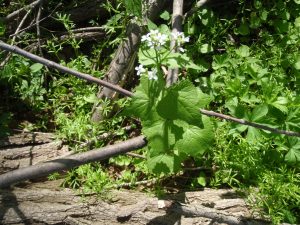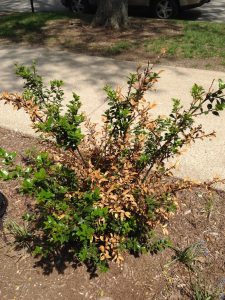Q. Could you tell me about the weed in the attached photo? I see them everywhere. Last year at the Celery Bog park, I noticed big piles of them where someone
had gone through and pulled them. Is it something new to our area in recent years? And is it considered invasive? – PB, Lafayette, Ind.
A. This notorious pest is called garlic mustard; it’s an invasive, biennial species that quickly colonizes where it lands. Biennials produce foliage the first
growing season, flowers and seeds the second year, and then that plant dies. What makes this species so invasive is that its seedpods pop open to release
hundreds of seeds, and, thus, a single plant can form a colony in just a couple of years.
The key to control is to prevent the plants from going to seed. The plant is easy to pull, especially following a rain. Repeated cutting back of the
second-year flower stalks will also prevent seed formation.
More information on garlic mustard is available at http://extension.entm.purdue.edu/CAPS/pestInfo/garlicMustard.htm
Q. I read with great interest your article about winter burn on shrubs. I have a rhododendron that was my grandmother’s, and she passed away many years ago. I
would love to save it if at all possible, but I am not sure what to do. It has both green and brown leaves on it. Should I prune it back, or just leave it
alone? Any advice you can give will be greatly appreciated. – SK, Derby, Ind.
A. The toll on our landscape plants from this past winter is still revealing itself, and I suspect we will continue to see some plant damage as summer heat
and dry spells come on. Injured plants will need all available green foliage for photosynthetic production of carbohydrate reserves to help with recovery.
Dead stems can be removed any time, but conservative pruning of even partially green twigs and branches is advised. You can always prune more after the
full extent of injury and potential for recovery is realized. Read on for a bit more on this topic.
Q. I read with interest your May column where you mentioned holly as being most susceptible to this past winter’s extreme temperatures. My lovely holly, which
has been around for at least 10 years, had at least three-fourths of it damaged. Leaves have turned brown and are dropping off. Will it grow back if I cut
it off 18 inches or more, or should it be replaced? – SH
A. I think it is a bit too soon to know whether the plant will fully recover, or if it would be best to replant anew. Dead stems can be removed any time, but
if the plant is to recover, it will need as much carbohydrate reserves as it can muster. Drastic pruning back to 18 inches would likely deplete what few
reserves it has.
A more conservative approach would be to remove any dead or badly damaged branches and retain as much of the green foliage as possible until it can recover
a bit. If all goes well, next year you can do a more gentile, renewal pruning, consisting of removing about one-third of the oldest (largest) branches back
to a few inches. Repeat this approach annually and by the end of the third year, the entire plant has been rejuvenated. Additional information on pruning
ornamental trees and shrubs is available at http://www.hort.purdue.edu/ext/ho-4.pdf.

